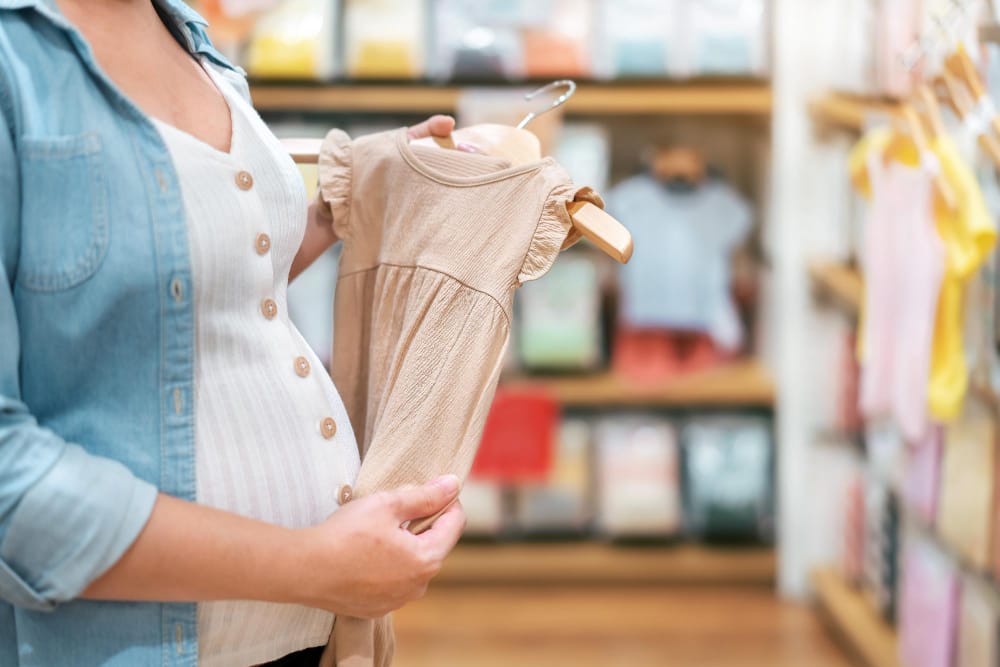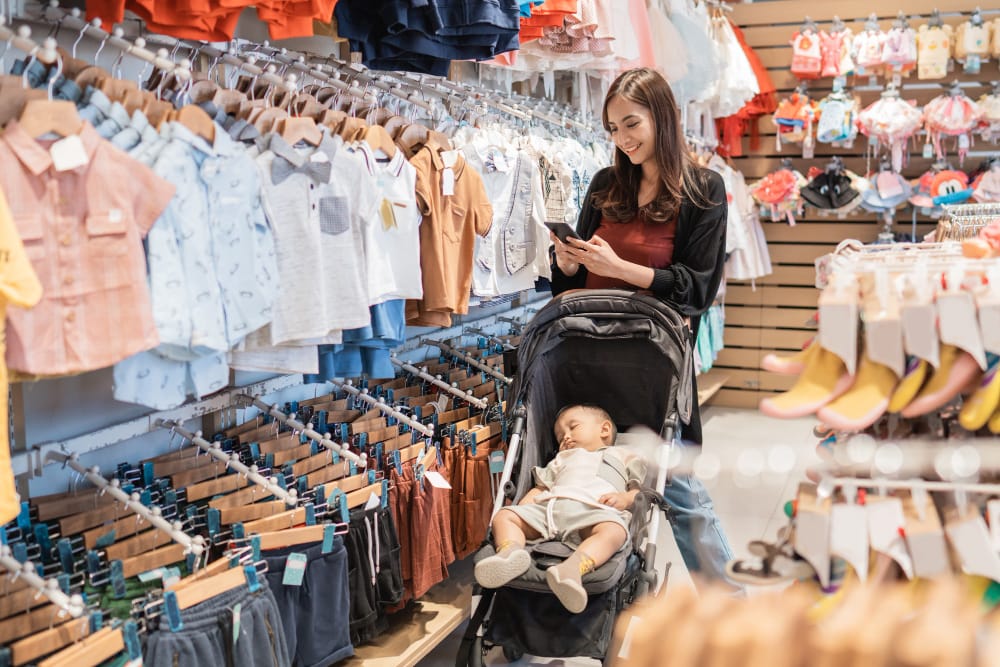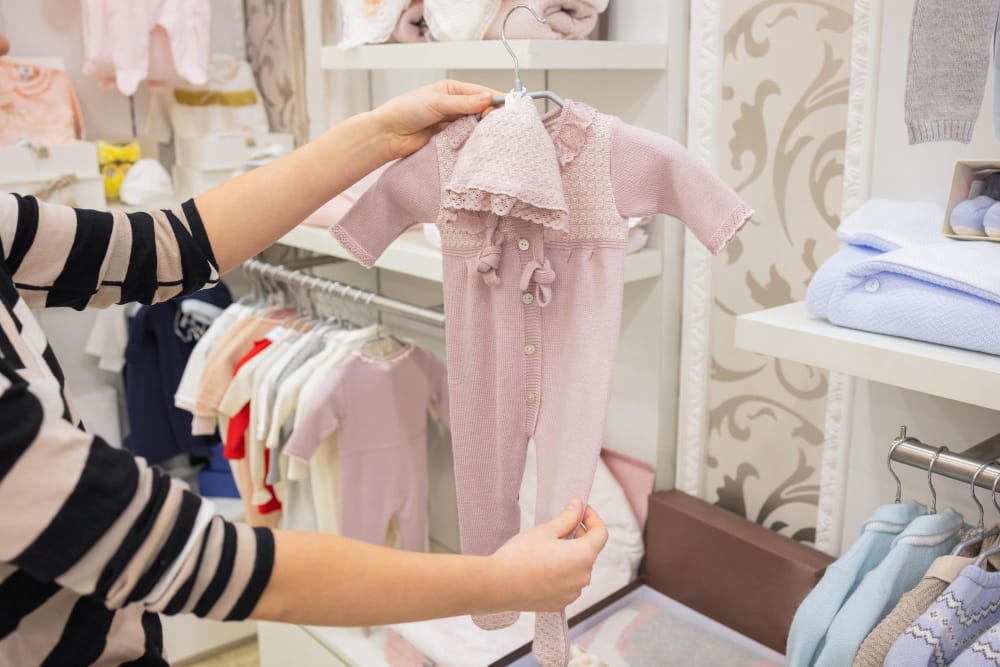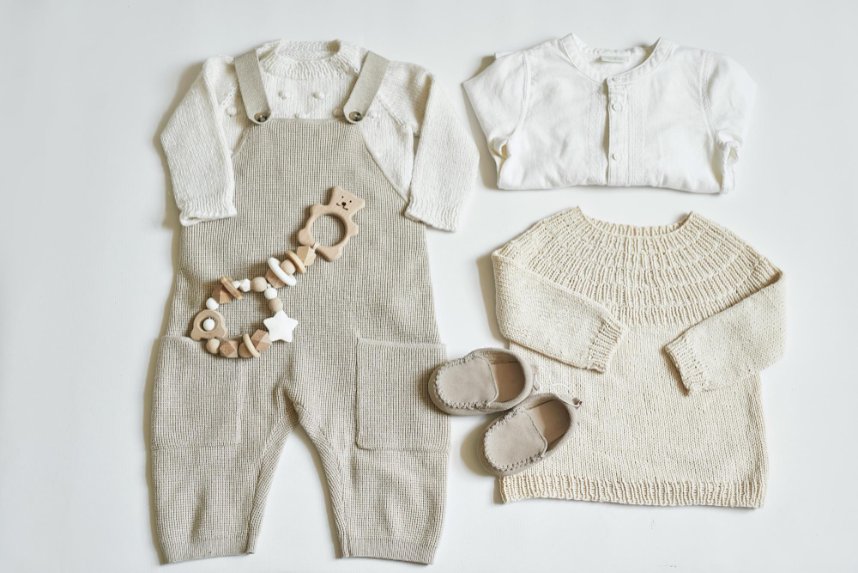A comprehensive guide to baby clothing costs, smart shopping strategies, and budgeting tips for new parents
Key Takeaways
- Baby clothes typically cost $5-25 per piece with annual spending averaging $640
- Quality materials, safety testing, and brand reputation drive higher prices
- Shopping secondhand, buying during sales, and choosing versatile pieces can reduce costs by 50-70%
- Organic options cost 20-40% more but offer health and environmental benefits
- Regional differences can affect costs by up to 80% (Mississippi vs Hawaii)
Table of Contents
Many parents discover that baby clothes can cost just as much as adult clothing, which often comes as a surprise. This comprehensive guide explores why baby clothing costs what it does and provides practical strategies to manage these expenses without compromising on quality or safety.
Understanding Baby Clothing Costs

Baby clothing prices vary significantly based on several factors including quality, brand, and where parents choose to shop. Understanding these cost drivers helps parents make informed purchasing decisions.
Average Costs by Category
| Item Type | Budget Range | Mid-Range | Premium |
|---|---|---|---|
| Basic Onesies | $3-8 | $8-15 | $15-25 |
| Sleepers | $5-12 | $12-20 | $20-35 |
| Everyday Outfits | $8-15 | $15-30 | $30-50 |
| Special Occasion | $15-25 | $25-50 | $50-100+ |
What Is the Average Cost of Baby Clothing?
According to the U.S. Department of Agriculture, parents typically spend around $640 per year on clothing for children ages 0-2. This breaks down to approximately $50 per month for the first year. However, costs can vary significantly based on shopping habits and preferences.
Monthly Baby Clothing Budget Calculator
For a more detailed budget planning experience, try our comprehensive budget planning worksheet.
Why Are Baby Clothes So Expensive?

Several factors contribute to the higher costs of baby clothing, many of which aren’t immediately obvious to parents.
Manufacturing and Safety Costs
Baby clothing manufacturing involves significant additional costs compared to adult clothing:
- Safety Testing: Rigorous testing for harmful chemicals, choking hazards, and flammability adds $2-5 per garment
- Premium Materials: Organic cotton and bamboo fabrics cost 30-50% more than conventional materials
- Specialized Labor: Skilled workers required for baby clothing production earn $15-25 per hour
- Smaller Production Runs: Limited quantities increase per-unit costs
- Regulatory Compliance: Meeting CPSC safety standards for children’s products adds manufacturing complexity
Cost Breakdown: $20 Baby Outfit
Brand Reputation and Design
Well-known brands like Gap Baby, Carter’s, and specialty boutique labels command premium prices due to:
- Investment in research and development for better fits and comfort
- Brand recognition and perceived quality
- Exclusive designs and seasonal collections
- Marketing and retail overhead costs
Brand Comparison & Sizing Guide
Understanding how different brands fit and their pricing strategies can help parents make better purchasing decisions. Our brand size comparison tool provides real-time recommendations based on your baby’s measurements.
Carter’s
Sizing: True to size
Price Range: $8-20
Best For: Everyday basics, consistent sizing
Gap Baby
Sizing: Runs large
Price Range: $12-35
Best For: Trendy styles, room to grow
Target (Cat & Jack)
Sizing: Slightly small
Price Range: $5-15
Best For: Budget-friendly options
Gerber
Sizing: Runs small
Price Range: $4-12
Best For: Basic essentials only
Sizing Strategy Guide
| Age | Weight Range | Size to Buy | Planning Tip |
|---|---|---|---|
| Newborn | 5-8 lbs | NB + 0-3M | Buy limited NB, more 0-3M |
| 0-3 months | 8-12 lbs | 0-3M + 3-6M | Stock up during this size |
| 3-6 months | 12-16 lbs | 3-6M + 6-9M | Buy ahead for next season |
| 6-12 months | 16-22 lbs | Current + next size | Focus on crawler-friendly styles |
Money-Saving Shopping Strategies
Smart shopping strategies can reduce baby clothing costs by 50-70% without sacrificing quality or safety.
@charlottes_life47 5 tips on how to save on baby clothes other than shopping second hand 💕 #babyclothes #babytips #babybudget
♬ original sound – charlotte
Where to Find Affordable Baby Clothes
Secondhand and Consignment Options
Secondhand baby clothes offer excellent value since most items are barely worn before being outgrown. Quality consignment shops and online marketplaces provide access to premium brands at fraction of retail prices.
- Consignment Shops: Curated selection, typically 30-50% off retail
- Thrift Stores: Lowest prices, requires more searching
- Online Marketplaces: Facebook Marketplace, eBay, Poshmark for specific brands
- Parent Groups: Local swap meets and clothing exchanges
For a wide selection of affordable baby clothes, including both new and gently used options, check out quality baby clothing collections that offer great value for money.
When to Shop Sales and Clearances
- End of Season: Buy winter clothes in spring, summer clothes in fall
- Black Friday/Cyber Monday: Many retailers offer 40-60% off baby clothing
- Back-to-School Time: Unexpected baby clothing sales in August-September
- Post-Holiday: January clearances for holiday-themed items
Bulk Buying Strategies
Purchasing baby clothes in bulk can significantly reduce per-item costs:
- Multi-packs: Onesie and sleeper sets often cost 30-40% less per piece
- Same-brand purchases: Consistent sizing reduces returns
- Size variety packs: Buy current size plus next 2 sizes during sales
- Basics focus: Stock up on neutral colors and simple styles
Sustainable & Organic Options
Why Choose Organic Baby Clothing?

Organic baby clothing offers several advantages despite higher upfront costs:
- Health Benefits: No harmful pesticides or chemicals against sensitive baby skin
- Environmental Impact: Sustainable farming practices reduce water pollution
- Durability: Higher quality materials often last longer
- Resale Value: Organic clothes maintain value better for resale
Cost Comparison: Organic vs Conventional
| Item Type | Conventional | Organic | Price Difference |
|---|---|---|---|
| Basic Onesie | $8-12 | $12-18 | +30-40% |
| Sleeper | $10-16 | $15-25 | +40-50% |
| Outfit Set | $20-30 | $30-45 | +35-45% |
Top Sustainable Baby Clothing Brands
- Burt’s Bees Baby: Affordable organic cotton, GOTS-certified
- Hanna Andersson: Premium organic options, excellent durability
- Kate Quinn Organics: Stylish designs, fair trade practices
- Colored Organics: Hypoallergenic materials, gives back to community
Baby Clothes Planning Guide

How Much to Save Before Having a Baby
Financial planning for baby clothes should begin early in pregnancy:
US Savings Recommendations:
- First Year Clothing: $500-800
- Total First Year Baby Costs: $14,680-36,050
- Monthly Clothing Budget: $40-70
UK Savings Recommendations:
- First Year Clothing: £400-650
- Total First Year Baby Costs: £11,000-28,000
- Monthly Clothing Budget: £30-55
What Age Should You Buy Baby Clothes?
Timing baby clothes purchases strategically can maximize savings:
- Second Trimester (20-28 weeks): Start with basics in newborn and 0-3 month sizes
- Third Trimester (28-36 weeks): Complete newborn wardrobe, buy 3-6 month sizes during sales
- After Birth: Assess actual baby size and adjust purchases accordingly
Essential Baby Clothes Checklist
| Item | Newborn | 0-3 Months | 3-6 Months |
|---|---|---|---|
| Onesies/Bodysuits | 4-6 | 8-10 | 6-8 |
| Sleepers | 3-4 | 6-8 | 5-6 |
| Pants/Leggings | 2-3 | 4-5 | 4-5 |
| Socks | 6 pairs | 8 pairs | 6 pairs |
| Hats | 2-3 | 2-3 | 2-3 |
| Swaddles/Blankets | 3-4 | 2-3 | 2-3 |
How Many Outfits Does a Newborn Need?
Newborns typically need 8-10 complete outfits in their current size. This accounts for multiple daily changes due to spit-up, diaper leaks, and general messiness. Having extras prevents constant laundry stress during those exhausting early weeks.
Should I Buy Newborn Clothes or 0-3?
The safest approach is to buy both, but in different quantities:
- Newborn size: 3-5 outfits (most babies wear this size at least briefly)
- 0-3 months: 8-12 outfits (longer wearing period, better value)
- Keep receipts: Return unused newborn items if baby skips the size
How Long Do Babies Wear Newborn Clothes?
Most babies wear newborn clothes for 2-8 weeks, depending on birth weight. Track your baby’s growth patterns with our interactive growth tracking chart to better predict clothing needs:
- Small babies (5-6 lbs): 6-8 weeks
- Average babies (6-8 lbs): 4-6 weeks
- Large babies (8+ lbs): 1-3 weeks or may skip entirely
Regional Cost Differences

How Much Does Children’s Clothing Cost Per Year in the US?
Regional variations in baby clothing costs can be substantial:
| Region | Annual Clothing Cost | Total Baby Costs | Cost of Living Impact |
|---|---|---|---|
| Mississippi (Lowest) | $450-550 | $15,555 | Base level |
| National Average | $600-700 | $18,000-22,000 | +20-30% |
| Washington State | $800-950 | $28,166 | +60-80% |
| Hawaii (Highest) | $850-1,000 | $30,000+ | +80-100% |
How Much Does Children’s Clothing Cost Per Year in the UK?
UK parents typically spend £500-750 annually on baby clothing, with London and southeast England seeing the highest costs. Regional variations exist but are less dramatic than in the US.
Practical Baby Clothing Considerations

How Often Should You Change a Baby’s Clothes?
Newborns typically need clothing changes 3-5 times per day due to:
- Diaper leaks and blowouts
- Spit-up and feeding messes
- Temperature regulation needs
- Comfort and hygiene requirements
This frequency decreases to 1-2 changes daily as babies grow older and feeding becomes less messy.
Do Baby Clothes Shrink a Lot?
Baby clothes made from 100% cotton can shrink 3-5% in length and width after the first wash. To minimize shrinkage:
- Wash in cold water (30°C/86°F or below)
- Air dry when possible
- Use low heat if machine drying
- Buy slightly larger sizes to account for shrinkage
What to Do with Baby Clothes That Don’t Fit Anymore?
Outgrown baby clothes have several valuable second lives:
- Save for future children: Store in vacuum bags by size
- Sell online: Poshmark, eBay, or Facebook Marketplace
- Donate: Local charities and family centers
- Gift to friends: Share with other parents who have younger children – use our hand-me-down planning tool to match sizes with friends’ children
- Consignment shops: Earn money while helping other families
Is It Cheaper to Make Baby Clothes?
Making baby clothes can be cost-effective for skilled sewers, but requires significant time investment:
Cost Comparison: DIY vs Store-Bought
| Item | Material Cost | Time Required | Store Price | Savings |
|---|---|---|---|---|
| Simple Onesie | $3-5 | 1-2 hours | $8-12 | $3-7 |
| Sleep Gown | $4-7 | 2-3 hours | $12-18 | $5-11 |
| Knitted Sweater | $8-15 | 15-25 hours | $25-45 | $10-30 |
Is It Cheaper to Knit or Crochet?
Crocheting is generally faster than knitting for baby items, making it more cost-effective when factoring in time:
- Crochet: Faster completion, uses slightly more yarn
- Knitting: Slower process, uses less yarn, creates finer fabric
- Both: Require initial investment in tools and learning time
Monthly Budgeting for Baby Clothes

How Much Do Parents Spend on Baby Clothes Per Month?
Monthly spending varies significantly based on shopping strategies and preferences:
- Budget approach: $25-35/month (thrift, sales, hand-me-downs)
- Moderate approach: $40-60/month (mix of new and secondhand)
- Premium approach: $80-120/month (mainly new, brand-focused)
How Much Does a Baby Cost Monthly in the US vs UK?
US Monthly Baby Costs:
- Total monthly costs: $1,100-2,500
- Clothing portion: $45-65 (4-5% of total)
- Regional variation: +/- 30% depending on location
UK Monthly Baby Costs:
- Total monthly costs: £850-1,900
- Clothing portion: £35-55 (4-5% of total)
- Regional variation: +/- 20% depending on location
Frequently Asked Questions
Conclusion
Baby clothing costs can feel overwhelming, but understanding the factors behind pricing helps parents make informed decisions. While baby clothes may seem expensive relative to their size, the investment in safety testing, quality materials, and specialized manufacturing justifies much of the cost difference.
Key Recommendations
- Budget wisely: Plan for $40-65 monthly, adjusting based on your region and shopping style – use our budget planning worksheet for detailed calculations
- Shop strategically: Combine secondhand finds with sale purchases of new items
- Size smart: Buy current size plus next size up, especially during sales – our size prediction tool helps plan future purchases
- Quality focus: Invest in basics that will last through multiple children
- Timing matters: Shop end-of-season sales for future sizes
- Consider sustainability: Organic options offer long-term value despite higher upfront costs
Remember that babies outgrow clothes quickly in the first year, making cost-per-wear more important than initial price. By focusing on versatile, durable basics and shopping smart, parents can keep their baby comfortable and stylish without breaking the budget.
The key is finding the right balance between quality, safety, and cost that works for your family’s specific situation. Whether you choose premium organic brands, budget-friendly basics, or a mix of both, the most important factor is ensuring your baby has clean, comfortable, and safe clothing for every stage of their rapid growth.
For additional guidance on choosing safe fabrics for newborns or selecting non-toxic baby clothes, explore our comprehensive guides designed to help parents make the best choices for their little ones.



